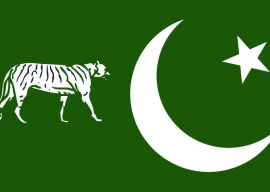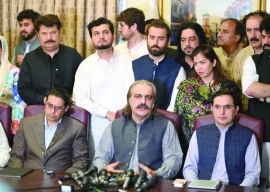
Talking of trends, men working at corporate sectors are progressively leaning towards a business casual style. Ditching the prescribed official attire for semi-formal Polo shirts surely sounds comfortable.
Abdur Rafay Khan, assistant manager, Pantaloons Apparel, a garment firm based in Dolmen Mall, says, “There was a time when wearing a simple crisp plain shirt and pleated regular fit formal pants and a tie to contrast was the ultimate dress code for the average office wear.”
Currently, the notion of the most suitable office wear comes down to embodying ‘comfy’ and ‘stylish’ at the same time. “As time evolved sharp colours, stripes, checks and khakis were the new thing and the slim fit shirts with contrasting fabrics are totally in. The cotton pants or the formal fabric pants have gone pleatless and slim fit,” adds Khan.

Talking about this drift in the making, Ziad Bashir, director, Gul Ahmed, comments “Definitely, work attire has grown trendier and people have started getting well-dressed as the competition has grown. Over time, Pakistan’s corporate division has been truly inspired by the English culture which gave us the edge to keep showing our western-inspired corporate lines at our retail.”
Khan stresses that a new category of semi formals has emerged that maintains a thin line between formal and casual wear: “Slim-fit dull cotton pants and a decent check or stripe shirt and casual cotton jacket is the best option for daily office wear.”
On the same note, Hanif Bilwani, CEO, Bonanza garments, that specifically deals in menswear denotes, “The trend of wearing a suit and a tie to work has declined considerably. People have moved to semi-formal clothing with double pocket shirts and soft collars. The colour trend has also changed. People have now started wearing dark colours to work as opposed to light colours.”
Another category in menswear that has stolen spotlight is ‘sports wear’.
Bilwani adds, “Majority of people have shifted to casual wear at work. Multinationals and private offices are the ones seeing this shift whereas people at banks are still in their formal attire most of the time.”
Bashir attributes this fact, saying, “As youth-oriented places such as school’s colleges, universities and creative offices are getting exposure of dressing, people have started adopting smart casuals at work. For example, dark blue jeans can be worn with a white dress shirt, paired with a blazer.”
How this trend-shift has affected the business of producing formal shirts, Bilwani shares, “The demand for formal shirts is still there but not as much.” However, there has never been a downward trend in the garment business, says Bashir. “What was fashion before has now become the basic today, meaning that market brands are working efficiently on designs and introducing new products to compete with the needs of the trendy.”
As to whether kurtas and short kurtis comply within the limits of semi-formal wear, Khan asserts, “Short kurtas can be included in casual wear and, no doubt, they do provide a connect with ethnic culture but there’s not a boom in their style just yet.”
Bashir concludes, saying that for casual wear, products like men’s tunics that are not actually the length of a kurta but end till the mid thighs are in vogue. He states, “Nevertheless, the Pakistani culture of kurta shalwar and its importance on days like Fridays is strong. That’s the reason we still create formal shalwar kameez or kurta shalwar that people can wear to work and still feel the sense of formal wear.”
Published in The Express Tribune, January 26th, 2015.
Like Life & Style on Facebook, follow @ETLifeandStyle on Twitter for the latest in fashion, gossip and entertainment.


















COMMENTS
Comments are moderated and generally will be posted if they are on-topic and not abusive.
For more information, please see our Comments FAQ